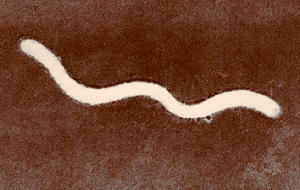Sulfurimonas denitrificans
A Microbial Biorealm page on the genus Sulfurimonas denitrificans
Thiomicrospira Denitrificans
Classification

Kingdom: Bacteria
Intermediate rank1: Proteobacteria
Intermediate Rank 2: Epsilonproteobacteria
Intermediate Rank 3: Campylobacterales
Intermediate Rank 4: Helicobacteraceae
Genus: Thiomicrospira
Species: denitrificans
Thiomicrospira, a group which originally included all marine, spiral-shaped sulfur oxidizing bacteria. Subsequent analyses of 16S rDNA sequences have revealed the polyphyletic nature of this group; members of Thiomicrospira are distributed among the gamma and epsilon subdivisions of the Proteobacteria. All Thiomicrospira species characterized to date are obligate chemolithoautotrophic bacteria that use sulfide, thiosulfate, and elemental sulfur as electron donors, and CO2 as their carbon source.
Reclassification Reports
Thiomicrospira denitrificans ATCC 33889 has been reclassified as Sulfurimonas denitrificans DSM 1251 (ATCC 33889)(Takai et al., 2006).
Description and Significance
Thiomicrospira denitrificans gains energy from the oxidation of reduced sulfur compounds.By the oxidation, denitrification is occurred. Electron donors utilized include reduced sulfur H2S, S2O32-, S° while O2 and NO3- can serve as electron acceptors (Kelly and Wood, 2001). By coupling the oxidation and reduction of inorganic compounds to the generation of biomass, the microbial activities tie the geochemical cycle of redox substrates to the carbon, nitrogen, and sulfur cycles.
Genome Structure
The genome of Sulfurimonas denitrificans DSM1251 was sequenced. This genome has many features, including a larger size (2.2 Mbp), that suggest a greater degree of metabolic versatility or responsiveness to the environment than seen for most of the other sequenced epsilonproteobacteria. A branched electron transport chain is apparent, with genes encoding complexes for the oxidation of hydrogen, reduced sulfur compounds, and formate and the reduction of nitrate and oxygen. Genes are present for a complete, autotrophic reductive citric acid cycle. Many genes are present that could facilitate growth in the spatially and temporally heterogeneous sediment habitat from where Sulfurimonas denitrificans was originally isolated. Many resistance-nodulation-development family transporter genes (10 total) are present; of these, several are predicted to encode heavy metal efflux transporters. An elaborate arsenal of sensory and regulatory protein-encoding genes is in place, as are genes necessary to prevent and respond to oxidative stress (Sievert SM et al., 2008).
Cell Structure and Metabolism
Thiomicrospirans have generated a good deal of interest in the scientific community because of their unique mode of metabolism, by which they can oxidize sulfur and reduce nitrate.
Ecology
Thiomicrospira denitrificans plays an important role in ecosystem, working on Sulfur transformation and Nitrogen cycle. T. denitrificans transforms sulfur through the process of sulfur oxidation,and turns nitrate to dinitrogen gas via denitrification. As with T. crunogena, 16S rRNA surveys have identified sequences closely related to T. denitrificans from several hydrothermal habitats (e.g. Reysenbach et al., 2000; Huber et al., 2003 cited in http://genome.jgi-psf.org/finished_microbes/thidn/thidn.home.html), indicating that these organisms might play an important role in these environments.
References
2. Sievert, S.M., Scott, K.M., Klotz, M.G., Chain, P.S., Hauser, L.J., Hemp, J., Hugler, M., Land, M., Lapidus, A., Larimer, F.W., Lucas, S., Malfatti, S.A., Meyer, F., Paulsen, I.T., Ren, Q., Simon, J., and the USF Genomics Class: "Genome of the Epsilonproteobacterial chemolithoautotroph Sulfurimonas denitrificans." Appl. Environ. Microbiol. (2008) 74:1145-1156.
3. Kelly, D.P., and Wood, A.P. (2001). The chemolithotrophic prokaryotes.
4. http://genome.jgi-psf.org/finished_microbes/thidn/thidn.home.html
